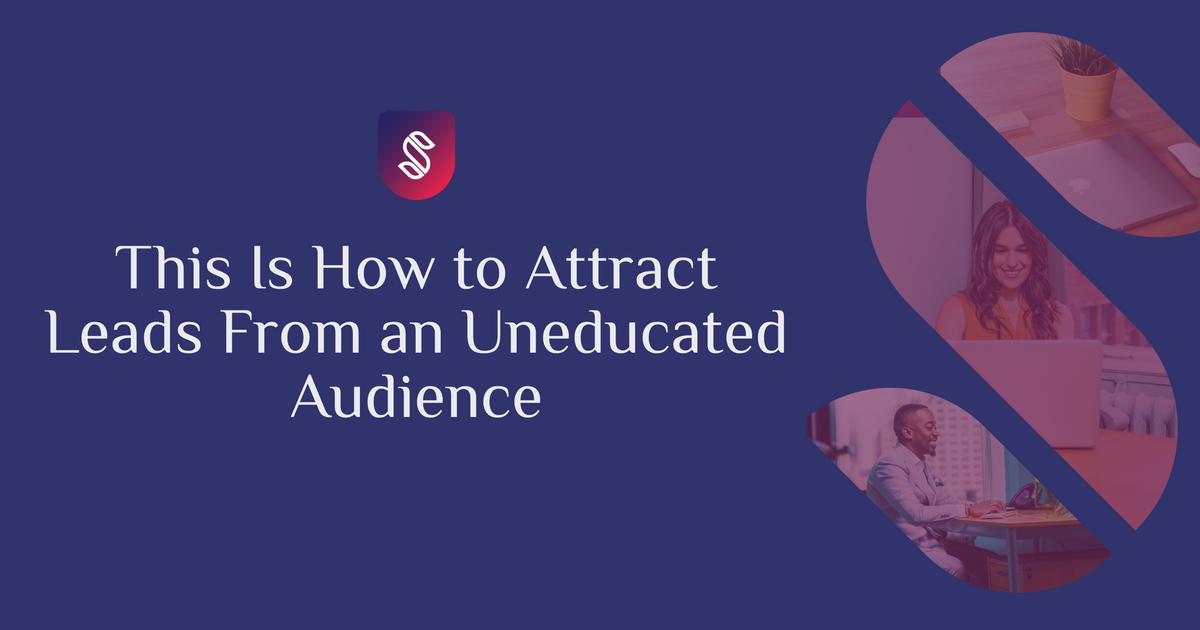Written on 24th June, 2021 | 4 min read
This Is How to Attract Leads From an Uneducated Audience
The key to generating leads from an uneducated market lies in shifting from building awareness to commercial intent queries.
Andreea Macoveiciuc
Strategist @School of Content

When I talk to business owners who struggle with content strategy, they typically have one of the following challenges:
They get high traffic volume but not enough leads
They get leads, but of poor quality
They get leads who are genuinely interested in the service, but not willing to pay for it
In most cases, these are consequences of going after the wrong audience or focusing on the wrong metrics.
The wrong audience has one thing in common
Both your ideal customer and the wrong target user are out there searching for things, but the intent behind their search is very different.
To get leads that convert, you need to go after potential buyers, not after learners. Unless, of course, your product is some form of educational material.
How do you know who’s a potential buyer and who’s just trying to gain more knowledge on a topic?
Just look at your own search patterns. When you want to get familiar with a new concept, you use broad, unspecific terms in your search queries. For example, someone who’s just starting to sell on Etsy might be searching for queries like “how to get more clients”.
This is a broad and unspecific query that shows learning intent more than commercial intent. The user is searching for something, but he’s not sure what he’s looking for. It could be a tool, a strategy, a list of tips, a webinar, a book, recommendations from others who’ve been there already.
Since it’s not clear what this user wants, it’s common sense to assume that he’s not going to convert right away if, for example, you’re selling a tool aimed at increasing open rates for newsletters.
Potential buyers use specific queries
Now let’s look at the potential buyer. His search queries will be much more specific and will show clear intent of converting when the right solution crosses his search path.
If this Etsy member already has a list of subscribers but he doesn’t see conversions from his newsletter, he might be googling for something like “increase conversions newsletters”, “free e-mail ab testing tools”, or “example e-mails that convert jewelry niche”.
These queries are more likely to result in conversions because:
the user is aware of the problem, so you don’t have to spend too much time educating him
the user is actively searching for a solution
However, there’s an even better audience that you can go after: the ones that are ready to spend money on the right solution. They did their research, they know what they’re looking for — a course, a book, a tool — and now they’re just comparing options.
Their search queries might look like this:
best e-mail conversion optimization too
Etsy CRO plugin/app
lead nurturing app
e-mail copywriting course
example of an e-mail that converts
This audience has already decided what type of solution they’re after, so you don’t need to waste time educating them and telling them the story from A to Z.
Now, what if you sell a solution that they’re not aware of? A product that’s so uncommon that your ideal customer doesn’t even know how to search for it? For example, a tool that analyzes e-mail copy and uses AI to rewrite it in a form that’s more likely to convert.
Don’t waste time educating the market, do this instead
If your target audience doesn’t know that such a tool exists, they will not look for it. They will not search for “AI tool to improve e-mail conversions”, so you can’t rely on search queries with high volume when writing your content or copy.
The solution for getting your product in front of them, without wasting time and money on awareness, is to hook into their story, to build on what they already know about.
Here’s what I mean. Your users don’t know about your tool, but they know:
what their problem is,
the approach they’re currently using for solving the problem,
and that their current approach is failing
So what you need to do if you want these people to try out your tool is to hook into their reality and start from there. Present your solution as a replacement or alternative to what they’re currently using.
If your audience knows that their problem is the poor e-mail conversion rate, and their current solution is A/B testing their copy with no success, build on that.
Insert your tool into their story by presenting it as the AI-powered replacement for manual A/B testing. Your tool may be unique, but the problem is not, so you don’t need to waste time educating the market.
By approaching your content from this perspective, you shift from creating content for “brand awareness” to publishing content for the middle and the bottom of the funnel.
This type of content is more likely to attract leads from an uneducated market and it doesn’t completely exclude the brand building.
What changes is that you’re presenting the product to users who are already in the right state of mind for buying. And if they need more education after learning about your solution, they’ll know how to find their way around your website for sure.
If you need help in identifying queries to target or researching your ideal customer profile, get in touch with our team. We'll audit your content, analyze your competitors and target audience, and create a content strategy for lead generation.